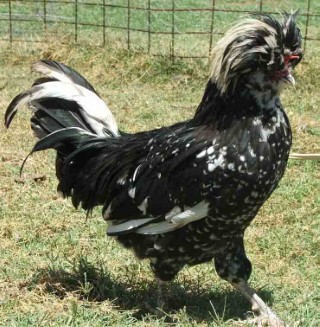Houdans are
dual-purpose chicken. In France they have a reputation as a high class table
fowl. Houdans produce a juicy, white meat with fine bones. They are also fair
egg producers: they lay two eggs a week for eight to ten years. Chicks mature
quickly without issues. They handle confinement; although, they prefer
foraging. Houdans can live on any soil type and secure most of their food by
their own efforts. The ornamental Houdan does better in warm, dry climates.
Their heavy head feathering freezes when cold and wet. Houdans produce less
offal than other breeds resulting in fewer parasites in the soils under them.
Houdans enjoy
human interaction. If handled early, the hens make great pets for children.
Houdan roosters have a large crest which limits their eyesight making them
potentially flighty and less suitable as pets. The docile Houdan fits well in a
family and on their small scale farm. Like most foraging breeds Houdans lead an
active lifestyle. They prefer walking over sitting on a nest to hatch brood.
Fortunately, they readily accept incubators or surrogate sitters for their
eggs.
Poultry affection
ados associate the Houdan with their spectacular crest, beard, and muffs. The Houdan
also has a unique and prominent “V” comb which distinguishes them from other
breeds. The Houdan's small wattles and earlobes disappear inside their head
feathering. Houdans have two basic color configurations—Mottled and White. The
standard rooster weighs eight pounds with the hen weighing in at seven. The
bantams average three pounds. Like some other French breeds, the Houdan has
five toes. The orientation of this fifth toe causes the Houdan to walk with a
classic Houdan skip.
Give your Houdans
a dry, spacious, and safe run for foraging. Houdans have a distinct
disadvantage against predators with their vision limiting crests. Plant grain
producing foliage. Houdans like to gather their own food when possible. Use
feed and water containers designed to keep their crest dry and clean. Houdans
lay well into old age. Supplement their feed with extra calcium and protein for
continued egg production. Houdans seldom hatch their eggs. Use an incubator or
surrogate sitter to hatch eggs. Hatch chicklings in the warm months to take
advantage of the heat.

